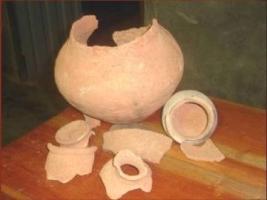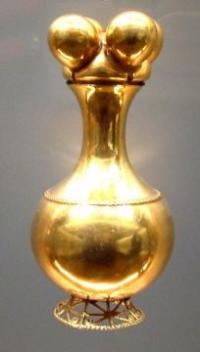Copy Link
Add to Bookmark
Report
Cider Digest #0882

Subject: Cider Digest #882, 24 November 2000
From: cider-request@talisman.com
Cider Digest #882 24 November 2000
Forum for Discussion of Cider Issues
Dick Dunn, Digest Janitor
Contents:
(none) (Nicholas Starin)
Degorgement (Tim Bray)
im-press-ive setup (Dick Dunn)
Send ONLY articles for the digest to cider@talisman.com.
Use cider-request@talisman.com for subscribe/unsubscribe/admin requests.
When subscribing, please include your name and a good address in the
message body unless you're sure your mailer generates them.
Archives of the Digest are available at www.talisman.com/cider
----------------------------------------------------------------------
From: Nicholas Starin <starin@teleport.com>
Date: Sun, 12 Nov 2000 12:06:42 -0800
Greetings,
I am new to the list and to cider-making. In fact, I have yet to actually
make my fist successful batch. I have a number of questions, but will try
to limit them.
1) I am looking for a good recipe that is appropriate as a first-time,
beginner's batch.
2) Can decent cider be made from stored, "supermarket" type apples (Fuji,
Delicious, etc.) in the late winter?
3) Can anyone recommend a good cider-making book? I already have the one
by Annie Proulx, which has a lot of good information, but I find it to be
strangely organized and a bit hard to use for the neophyte.
4) I am looking to locate some used equiptment in the Portland, Oregon
area. Basically I need everything: carboys, air lock, capper, etc. I also
would like to get a fruit press. Any ideas about how to find used
equiptment? What is the best shop in the Portland area for equiptment, and
supplies?
5) Is there a Portland-area cider group that meets from time to time; are
there any workshops/classes offered around here?
Nicholas T. Starin
Portland, Oregon
------------------------------
Subject: Degorgement
From: Tim Bray <tbray@mcn.org>
Date: Tue, 14 Nov 2000 19:27:24 -0800
A few months ago I asked about degorgement and got a couple of
responses. I recently tried it and thought I would pass on my results.
The cider was bottled too early, when the SG was about 1.012; it is now
1.000. There is considerable pressure in the bottles! I thought this
would be more of a problem, but the process actually worked well. The
cider is in champagne bottles with caged plastic corks. I turned the
bottles upside down and left them to chill for several weeks, spinning them
a few times along the way to make sure all the yeast settled into the
necks. By the time I degorged, there was about 2 inches of yeast in the
necks (plus what's in the plastic corks).
As this was a test, I did it on a small scale, one bottle at a time. I
used a 22 oz insulated plastic cup, half filled with crushed ice, with a
couple of tablespoons of table salt mixed in. Crammed the neck of the
bottle into the ice up to about 1/2 inch past the yeast. Left it in and
checked periodically; it seemed to take about 15-20 minutes to
freeze. (Cider was chilled to about 45 - 50 F when I started.) Meanwhile
I prepared a clean, sterile new cork. When the stuff froze, I took the
bottle out, rinsed the neck quickly, then took it outside and carefully
removed the cork. The frozen yeast sludge slowly emerges, and then as soon
as the frozen part is ejected the cider starts to foam. Fortunately this
wasn't as violent as I was expecting, and it was not too difficult to seat
the new cork.
There were two slight difficulties:
One, the frozen yeast did not always cleanly emerge from the bottle before
the foaming started. Because the plug is tapered, the wider part sometimes
became lodged in the neck while cider foamed out around it. I used a clean
wooden pick to break these plugs so they would eject.
Two, even after ejecting the plugs and losing some foam, there is still way
too much carbonation left in the bottle, so I had to slowly release
pressure for a few minutes until it was safe to cork again. Otherwise,
when the bottle was uncorked later, the pressure drop would cause excessive
foaming and loss of cider. It was not too difficult to control the
pressure loss and still maintain adequate residual carbonation.
The resulting cider, after settling down for a while, is much improved - no
nasty yeasty taste - but still much drier and too acidic for my taste. So
I mix it with fresh sweet juice (from the same pressing, but frozen instead
of fermented) and get a terrific low-alcohol, lightly carbonated (Bouche'),
sweet cider!
Next step is to try that blend, then bottle and pasteurize, and see if the
fresh apple taste can be preserved.
Cheers!
Tim Bray
Albion, CA
------------------------------
Subject: im-press-ive setup
From: rcd@raven.talisman.com (Dick Dunn)
Date: 24 Nov 00 10:48:23 MST (Fri)
Some weeks ago (ever notice how time flies when you're planning to write
something "as soon as I get a few free moments"?:-), I had the privilege
to watch and help a little with an apple pressing event set up by Greg and
Steve Jordan--two local people who are also Cider Digest subscribers.
What impressed me was the way they've set up a very effective pressing
operation using equipment they've "scrounged", pieced together, and built,
without spending a lot on it. The actual pressing turned out over 140
gallons of juice in not much over two hours. Set-up and clean-up added to
that, but the main event was still relatively fast and efficient. So,
with Greg's permission, I wanted to sketch out the whole arrangement, as
it might help give the rest of us ideas. Greg told me that they'd been
building and fine-tuning the setup for a number of years. This shows.
The centerpiece, in my mind, is the press. It's hydraulic. Everything
I've seen (other small-scale setups as well as the Jordans') says that if
you go beyond a couple dozen gallons on a pressing day, the best thing you
can do is ditch that hand-operated screw press and use a hydraulic cylinder.
It's faster and easier, and you really improve your yield.
The press framework is basically an open rectangle made of heavy I-beams.
The hydraulic cylinder is mounted at the center of the top cross-beam and
drives a pressing plate downward. The initial juice collection, as well
as the support for the cheese (the stack of pulp and frames to be pressed),
is a large stainless steel basin sitting on the lower cross-beam with some
additional supports. The cheese is built as a relatively tall/narrow
stack...I think I remember it as about 14" square. They entirely enclose
the stack--imagine a stainless-steel box with open ends, bottom end sitting
on the basin and top end open for the press plate. The enclosing box is
made of two pieces--three sides as one piece, and a separate piece for the
front so you can slide the press racks and cloths filled with pulp in and
stack them up, then latch the front side on to complete the square box.
They said they'd gone to this enclosed design because they'd had trouble
with an open cheese wanting to slip and slide off-center. My conjecture
is that this is due partly to the relatively tall/narrow geometry of the
cheese setup. However, I think the enclosure is still a good idea, since
it allows some slop and a lack of skill in building the layers of the
cheese--they can use clumsy volunteers like me and still do the pressing
quickly. The tall/narrow arrangement also presumably allows less expense
in pressing racks. As I recall, they were using something like six to
eight layers.
The pressing racks were two layers of oak slats at right angles to give a
lattice pattern. Pressing cloths were heavy and relatively coarse fabric.
They'd made open square frames which fit just around the press racks, a
couple inches high. The lower inside edges of the frames were rabbeted to
lock over the racks. This wouldn't be necessary, but it helped when the
build-up got a little crowded and there wasn't a convenient flat place
large enough to set rack/frame. Procedure was to lay the rack on the
table, lay the frame around it, lay the cloth on top of the frame and push
it into the corners, fill the cloth up to the level of the frame with
pulp, fold the cloth over the pulp, lift the frame off and lift the press
rack with pulp-filled cloth into the metal box on the press. If the apple
grinding was keeping up, it was a matter of a few minutes to build the
cheese. The frames were a great help in getting the layers square and
filled to a good uniform depth without much skill. Work tables for
filling the frames were made from panels of stainless. These tables had
low (fraction of an inch) rims around them, which was good to keep the
excess free juice from running off all over the place.
Back to the press...The juice drained into the shallow catch-basin at the
base of the press, then through holes in the basin through hoses with
coarse filters on the end, into a somewhat smaller/deeper basin which
seemed to allow some settling. A small peristaltic pump (*nice* bit of
scrounging there!) and tubing lifted the juice from this second basin into
a 250 gallon stainless tank. The tank is surplus dairy equipment, double-
wall with a chiller unit. We were working on a pleasantly warm day, and
the chiller had the juice down under 50 F by the time we were done pressing.
Let me interject here that almost all of the equipment that mattered for
coming into contact with the apples once crushed, or with the juice, was
stainless. Exceptions were the press racks and cloths, buckets (food-
grade plastic) for transferring the pulp, and the plastic tubing used in
the lift pump. Stainless is nice stuff! It's durable, won't taint the
juice, and is easy to clean. It is expensive, of course, but if you're
good at auctions and scrounging you might be surprised what you can come
up with. Surplus dairy equipment (as with the tank/chiller) is often a
good source of really nice stainless...homebrewers have been onto this for
years. It also helps, in the Jordans' case, that Steven does professional
metal work, including working stainless, and has a good metal shop! But it
seems to me that if you're not so lucky when you're building a setup of
your own, you just need to find someone who's good with metal and likes
cider.
Now, back up to the washer and grinder. The apples started out in boxes in
a truck and on a trailer so that people could stand on the bed and lift the
boxes of apples into the washer, but it wasn't a stretch at all. Apples go
through the washer, drop into the feed chute for the grinder, and the pulp
drops out of the grinder into plastic buckets which are then lifted up to
the work tables where the press cloths are filled. Lesson here is to think
about how many times, and how far, things get lifted in going through the
process. These guys had it planned pretty good, so nobody got tired out.
The washer was another excellent bit of scrounging--I'm told it was
originally part of a test station at a sugar-beet processing plant, where
they could wash small batches of beets before processing them to assay them
for sugar content. Anyway, it's about the size of a barrel, tilted.
There's an inner cage that turns. The apples get dumped into the cage and
sprayed with water as the cage turns. There's a pump to recirculate the
wash water. Underneath the washer is a basin (looked suspiciously like an
old bathtub:) which holds wash water and lets the dirt settle out before
the water is pumped back up. There's a mechanical linkage from a foot
pedal at the input side of the washer-drum to a flap at the lower output
side, to release the apples into a chute to feed the grinder.
The grinder is a sort of box with open top and bottom, and the usual
cylinder which almost completely fills the opening of the box. The cylin-
der is a PVC sleeve over wood, and the scratching teeth are very short
pieces of stainless welding rod set in the cylinder at a slight angle and
ground at a slight angle so they would grab the apples and tear them.
These teeth were set in a pattern which I was assured was scientifically
random. It was a relatively open pattern, and it did a great job of
producing a uniform pulp.
For those of us who don't happen to have stainless welding rod and a
grinding setup handy, I recall seeing at Kevin Minchew's cidery another
clever approach to setting teeth in the grinder cylinder: Use stainless-
steel flat-head wood screws driven into the cylinder. I noticed that the
pattern Kevin had used was relatively tightly set compared to the teeth in
the Jordans' grinder. I'm curious whether anyone knows how this might
affect the efficiency of grinding, the uniformity and size of the pulp, or
the power required for the grinder.
The grinder did suffer one minor problem: It wouldn't start if there were
apples already in the grinder; it had to come up to speed before releasing
apples down the chute. But I don't think this is an unusual problem, and
it's not difficult to avoid if you provide for a way to block apples until
the grinder is ready for them. I guess the tradeoff is speed/power, and
with a grinder, speed is an advantage in order to keep chipping bits off
the apples instead of grabbing them and pulling chunks through by main
force.
The grinder had a lid over the box containing the cylinder; the chute
entered from the side at a shallow angle. I have to think the lid is a
good idea for when there are children present, since any grinder is an
obvious potential hazard. I didn't see anyplace else where I'd worry about
hazards in the equipment.
Greg took some snapshots which would help to make the explanations clearer.
I'll put those up on a web page as soon as I can, but I want to get this
out...this article, as well as the Cider Digest, are way overdue.
- ---
Dick Dunn rcd@talisman.com Hygiene, Colorado USA
...Simpler is better.
------------------------------
End of Cider Digest #882
*************************
























